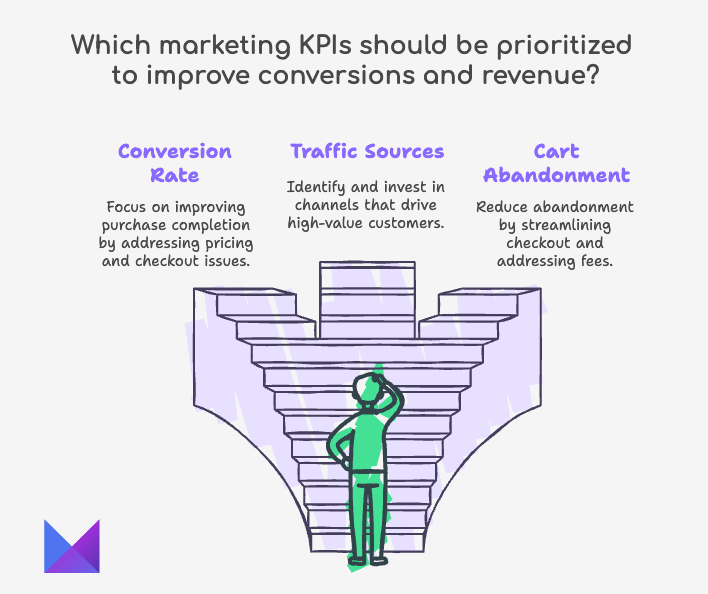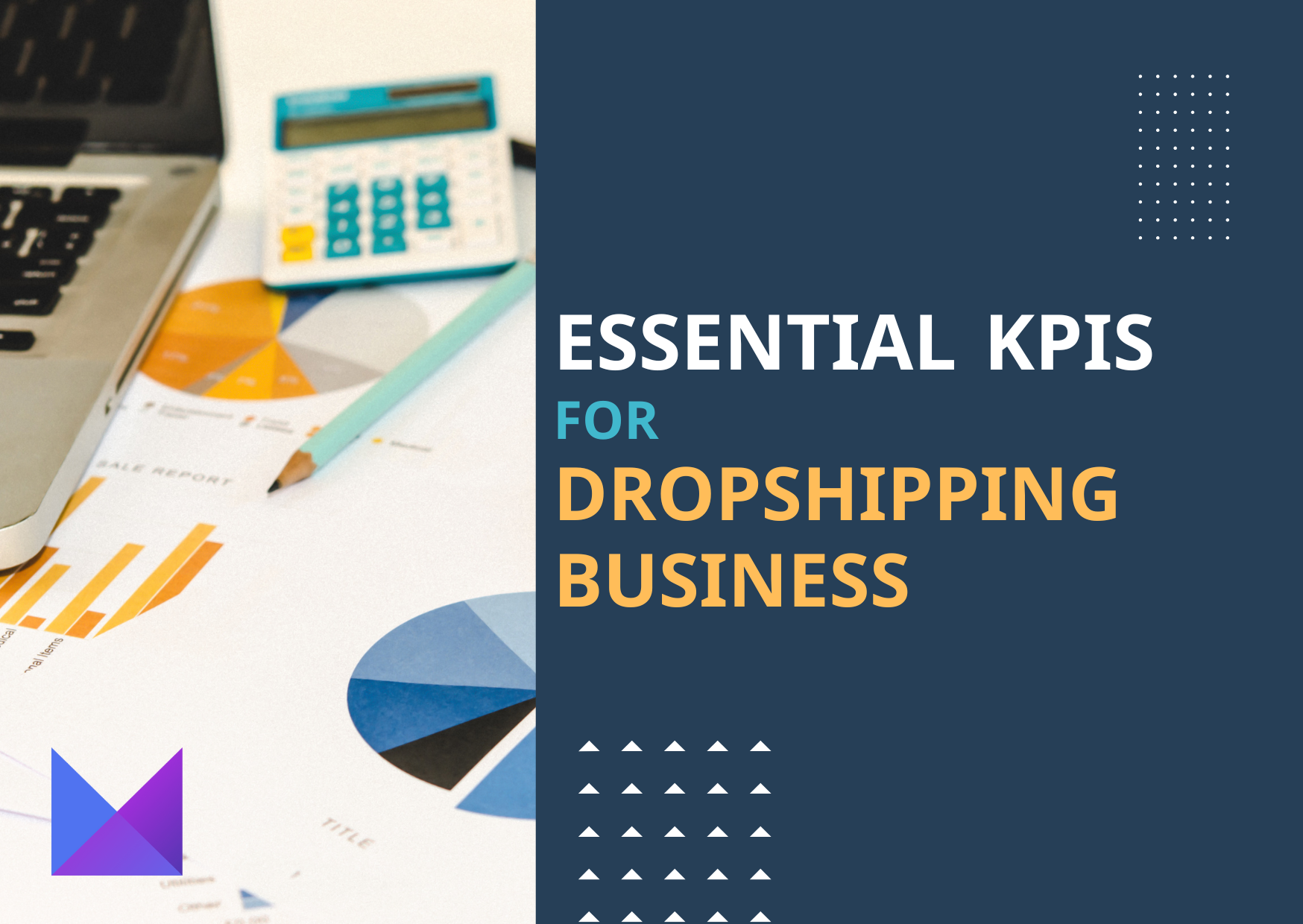Your dropshipping store is live, but are you building a profitable business or simply breaking even?
That’s where KPIs, or key performance indicators, come into play. These vital metrics provide insights into what’s driving your success, where you might be losing money, and how to scale your business more effectively. By analyzing areas like revenue, marketing performance, and customer retention, KPIs eliminate the guesswork and transform data into actionable strategies.
Ready to take your business to the next level? Let’s explore the essential metrics every dropshipper should monitor.
What Are KPIs?
Key Performance Indicators (KPIs) are measurable metrics that reveal how effectively your business is achieving its goals. They offer valuable insights into areas like sales, marketing, customer retention, and operations, empowering you to make smarter, data-driven decisions.
KPIs answer critical questions such as:
- Are your ads converting viewers into paying customers?
- Is your revenue growing or simply covering your expenses?
- Are slow shipping times affecting repeat purchases?
By tracking the right KPIs, you can identify trends, address inefficiencies, and scale your business with greater confidence and clarity.
Key KPIs Every Dropshipper Must Track
To succeed in dropshipping, focus on four critical areas: financial performance, marketing and sales, operations and customer service, and HR metrics. Here’s how to get started with the financial metrics that matter most:
Financial KPIs
High sales don’t always translate to high profits. Monitoring these essential metrics ensures you control costs and boost earnings:
Cost of Goods Sold (COGS): This includes supplier costs, shipping fees, and transaction charges. The lower your COGS, the higher your profit margins. Regularly review it to maintain smart pricing and maximize profitability.
Customer Acquisition Cost (CAC): How much are you spending on ads, influencer collaborations, and promotions to gain a single customer? If CAC gets too high, your profits will evaporate. Experiment with different marketing strategies to keep it manageable.
Average Order Value (AOV): Larger orders mean higher profits. Boost your AOV by encouraging upsells, bundles, and volume discounts to make each sale more valuable.
Why These Metrics Matter: A well-optimized pricing and cost structure leads to greater profitability per sale. By tracking these KPIs, you can minimize waste, set competitive prices, and scale your business sustainably.
Marketing & Sales KPIs
Driving traffic to your site is one thing—turning visitors into paying customers is the real challenge. These KPIs can help you identify what’s working and what’s sabotaging your conversions:
Conversion Rate – How many visitors are actually completing a purchase? A low conversion rate indicates potential issues like pricing, confusing product pages, or checkout obstacles. Test and refine to boost performance.
Traffic Sources & Performance – Not all traffic is created equal. Are your highest-value customers coming from Google, Facebook, or TikTok? Identify your best-performing channels and focus your efforts—and budget—on sources that drive buyers, not just browsers.
Cart Abandonment Rate – Shoppers fill their carts but don’t follow through. A high abandonment rate often signals problems like unexpected fees, a clunky checkout process, or slow page speeds. Address these roadblocks to reclaim lost sales.
Customer Lifetime Value (CLV) – One-and-done shoppers make growth difficult. A higher CLV means more repeat buyers, reducing your reliance on constant new customer acquisition. Invest in strategies that encourage loyalty.
Return on Ad Spend (ROAS) – Running ads? ROAS tells you if they’re worth it. A 3:1 ROAS means you earn $3 for every $1 spent. Monitor this to scale your ad campaigns wisely and profitably.
Why it matters: Optimizing your marketing doesn’t just save money—it maximizes revenue. Focus on strategies that convert, eliminate what doesn’t, and watch your business thrive.
Operational & Customer Service KPIs
Even the best marketing can’t save a business from poor customer experiences. To drive repeat sales and maintain a loyal customer base, track these essential KPIs:
Fulfillment & Shipping Times – Dropshipping often comes with longer delivery times. Monitoring delays allows you to select reliable suppliers and set clear, realistic expectations for your customers.
Order Accuracy Rate – Mistakes in orders lead to refunds, negative reviews, and lost trust. Strive for an accuracy rate above 99% to ensure customer satisfaction and minimize errors.
Customer Satisfaction & Reviews – Positive reviews build credibility, while negative feedback highlights areas for improvement. Regularly track ratings and address complaints promptly to maintain a strong reputation.
Refund & Return Rates – High return rates may point to product quality issues, misleading descriptions, or poor packaging. Resolving these problems can improve profits and strengthen customer trust.
Why it matters: Satisfied customers spend more, return less, and recommend your business to others. Efficient operations are the backbone of a profitable, well-run business.
HR & Team Performance KPIs
Your team does more than just handle orders and provide support—they shape the entire customer experience. Slow responses, repeated mistakes, or high turnover can erode trust and hurt sales. To ensure your team performs at its best, track these essential KPIs:
Employee Productivity
How much is each team member accomplishing? A sudden drop in productivity might signal unclear responsibilities, inadequate training, or uneven workloads.
Customer Support Response Time
Nobody likes waiting. Faster response times lead to happier customers. Monitor how quickly your team replies, and aim for prompt, helpful support.
First Contact Resolution Rate
Are customer issues resolved on the first attempt, or do problems persist? A high resolution rate reduces frustration for both customers and your team.
Employee Retention & Turnover Rate
Frequent staff turnover slows operations, frustrates customers, and disrupts service quality. Tracking this metric can help you improve hiring practices and retain skilled employees.
Training & Onboarding Efficiency
How quickly can new hires become fully productive? A smooth onboarding process accelerates learning and equips employees to contribute sooner.
Why It Matters
A well-trained, efficient team results in happier customers, fewer errors, and better overall performance. By monitoring these KPIs, you can build a stronger, more reliable workforce that drives success.
How to Track KPIs Effectively
Tracking KPIs for your dropshipping business isn’t just about gathering data—it’s about using that data to make smarter, growth-driven decisions. The secret? Automate as much as possible and focus on metrics that truly impact your success.
Automate Tracking with the Right Tools
Stop wasting time manually checking numbers across multiple platforms.
Let these tools handle the heavy lifting for you:
- Google Analytics – Monitor website traffic, conversion rates, and bounce rates.
- Shopify Reports – Get insights into revenue, average order value (AOV), and cart abandonment rates.
- Wix Analytics – Analyze visitor behavior, sales trends, and conversion performance on your Wix-powered store.
- Facebook Pixel & Google Ads Manager – Track ad performance, customer acquisition costs, and campaign ROI.
- Email Marketing Tools (Klaviyo, Omnisend) – Measure email open rates, clicks, and conversions to refine your campaigns.
- Accounting Software (Xero, QuickBooks) – Keep financial KPIs like revenue, expenses, and profit margins well-organized.
By leveraging these tools, you can streamline KPI tracking and focus on what really matters: growing your business.
Create Centralized Dashboards
Streamline your workflow by consolidating key KPIs into a single, real-time dashboard. No more switching between platforms — everything you need is in one place.
- Google Data Studio: Build custom dashboards that aggregate data from multiple sources.
- Zapier Automations: Seamlessly sync data across tools for up-to-date insights.
By setting up centralized dashboards, you can effortlessly track trends and make data-driven decisions without wading through endless reports.
Set Data-Driven Benchmarks & Goals
Tracking KPIs without context is ineffective. To set meaningful goals, rely on industry benchmarks and historical performance for guidance.
For instance:
- – A cart abandonment rate of 70% compared to an industry average of 55-65% signals a serious issue.
- – If your customer acquisition cost (CAC) is rising while customer lifetime value (CLV) remains stagnant, it’s time to reevaluate your retention strategy.
- – A lower average order value (AOV) than competitors suggests opportunities to test product bundling or upselling.
Regularly review your KPIs, whether weekly or monthly, and make incremental, data-informed adjustments instead of relying on instinct.
Strategies to Boost Dropshipping Performance
Tracking KPIs is only valuable if it leads to actionable improvements. Here’s how you can enhance critical areas of your business using the data you collect.
Refine Pricing and Maximize Profit Margins
Small pricing adjustments can significantly impact your bottom line. Rather than guessing, base your pricing strategy on key factors like cost of goods sold (COGS), competitor pricing, and customer demand.
- Experiment with tiered pricing models, such as offering discounts for bulk purchases.
- Leverage psychological pricing (e.g., $29.99 instead of $30) to drive conversions.
- Negotiate with suppliers to reduce costs per unit without sacrificing quality.
By strategically optimizing your pricing, you can increase both revenue and profitability while maintaining a competitive edge in the market. A key part of this process is understanding your profit margins to ensure your pricing strategy aligns with your financial goals. To make this easier, you can use tools like a profit margin calculator to analyze and refine your pricing approach.
Increase Your Website’s Conversion Rates
Driving traffic to your website is important, but if visitors aren’t converting, you’re leaving revenue on the table. Here’s how to turn clicks into customers:
- Run A/B Tests: Experiment with product page layouts, refine descriptions, and adjust CTA placements to see what resonates best with your audience.
- Optimize Site Speed: Enhance loading times by compressing images, enabling caching, and removing unnecessary plugins. Faster sites keep visitors engaged.
- Build Trust: Boost credibility by adding security badges, displaying customer reviews, and offering money-back guarantees to reassure potential buyers.
Make every visitor count with these actionable steps!
Minimize Cart Abandonment
A high cart abandonment rate indicates shoppers are interested in your product but hesitate to complete the purchase. Here’s how to address it:
- Streamline the checkout process: reduce steps, minimize form fields, and offer a guest checkout option.
- Use automated cart recovery emails—offering a small discount can be a powerful incentive.
- Be transparent about shipping costs upfront to avoid unexpected fees at checkout.
Boost Customer Retention
Acquiring new customers is often more expensive than keeping existing ones. Transform one-time buyers into loyal repeat customers with these strategies:
- Implement a loyalty program to reward repeat purchases.
- Send automated post-purchase emails featuring personalized product recommendations.
- Offer subscription options for refillable products like skincare or supplements.
Discover more tips for building customer loyalty here.
Build Stronger Supplier Relationships
Slow fulfillment and inconsistent product quality can harm your reputation and hurt repeat business. Strengthen your supplier partnerships with these strategies:
- Partner with suppliers known for reliable, fast shipping.
- Regularly evaluate supplier performance by monitoring late shipments, defect rates, and customer feedback.
- Maintain a backup supplier to prevent stock shortages and delivery delays.
Strengthen Your Team
A well-trained, motivated staff keeps operations smooth and customers happy.
- Train new hires with a structured process to get them up to speed fast.
- Track productivity, give clear feedback, and set performance goals to keep your team sharp and efficient.
- Keep top talent by offering fair pay, recognizing top performers, and building a positive work culture.
- Use chatbots for FAQs, set response time targets, and staff up during peak hours to keep support running smoothly.
Final Thoughts
Success in dropshipping hinges on tracking the right metrics and making informed, data-driven decisions. Key performance indicators (KPIs) illuminate what’s fueling your success and highlight areas that need improvement.
By consistently analyzing these metrics and fine-tuning your strategy, you can enhance efficiency, increase profitability, and foster customer loyalty. Don’t rely on guesswork, start tracking your KPIs today to take control of your business’s growth and unlock its full potential.


